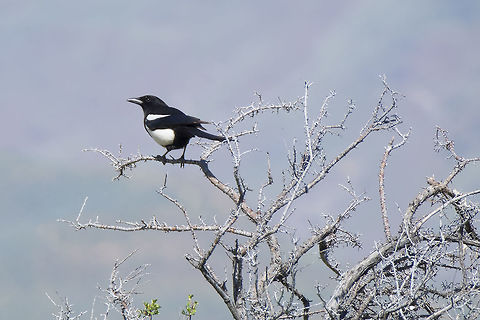
Appearance
The adult black-billed magpie is 45–60 cm long and weighs 145–210 g. Males are generally 6–9% larger and 16–20% heavier than females. The tail is long and makes up half of the bird's length. Wingspan is about 60 cm. The bird is black with white shoulders, a white belly, and iridescent dark blue-green wings and tail. There are large white markings on the primaries, clearly visible in flight. The feet and bill are black.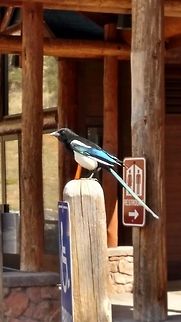
Distribution
Black-billed magpies range in the north from coastal southern Alaska, central British Columbia, and the southern halves of Alberta, Saskatchewan, and Manitoba, through the Rocky Mountains down south to all the Rocky Mountain states including New Mexico, Colorado, Utah, Wyoming, Idaho, and some bordering states as well. The range extends as far east as northern Minnesota and Iowa, with casual records in northern Wisconsin and upper Michigan, but is thought to be limited further east and south by high temperature and humidity.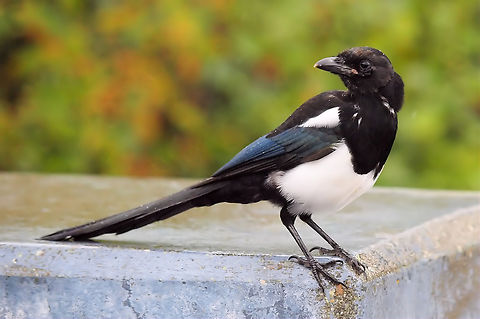
Habitat
Black-billed magpies frequent open country with thickets and scattered trees, especially riparian groves. They can be found near farms and within cities and suburbs. Dry open pine forests are another possible habitat.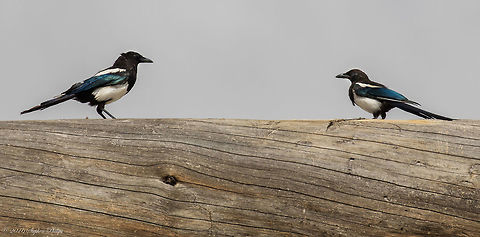
Reproduction
Adult black-billed magpie pairs stay together year-round and often for life unless one dies, in which case the remaining magpie may find another mate. Divorces are possible: one South Dakota study found low rates of divorce but one 7-year study in Alberta found divorce rates up to 63%.Black-billed magpies nest individually, frequently toward the top of deciduous or evergreen trees. Only the nest tree and its immediate surroundings are defended, and so it is possible for nests to be somewhat clumped in space. When this happens, a diffuse colony is formed. In this the black-billed magpie is intermediate between the European magpie, whose nests are much more spread out because a large territory is defended around each nest, and the yellow-billed magpie, which is always loosely colonial.
Nests are loose but large accumulations of branches, twigs, mud, grass, rootlets, bark strips, vines, needles, and other materials, with branches and twigs constituting the base and framework. The nest cup is lined with fine rootlets, grass, and other soft material. Nests almost always include a hood or dome of loosely assembled twigs and branches, and usually have one or more side entrances. Nests are built by both sexes over 40–50 days, starting in February. Old nests can be repaired and used, or a new nest can be built on top, with older nests thus reaching 120 cm high by 100 cm wide. Other bird species, including small hawks and owls, often use old magpie nests.The breeding season for magpies is generally from late March to early July. They nest once a year, but may re-nest if their first attempt fails early. The female lays up to thirteen eggs, but the usual clutch size is six or seven. The eggs are greenish grey, marked with browns, and 33 mm long. Only the female incubates, for 16–21 days. The male feeds the female throughout incubation. Hatching is often asynchronous. Hatched young are altricial, brooded by the female but fed by both sexes. They fly 3–4 weeks after hatching, feed with adults for about two months, and then fly off to join other juvenile magpies. Fledging success is lower than clutch size; this is not an unusual state of affairs in species with asynchronous hatching, as some nestlings often die of starvation.
Black-billed magpies breed for the first time at 1 or 2 years of age. The lifespan of the species in the wild is about four to six years.
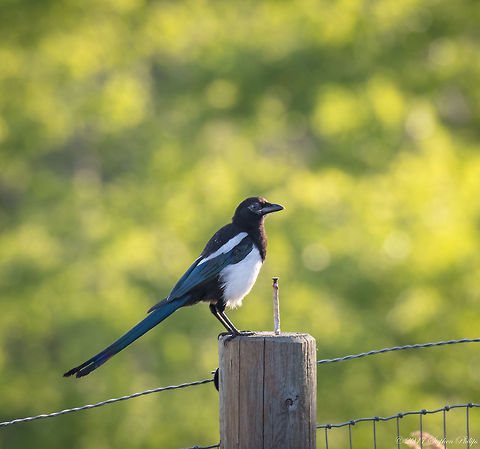
Food
The black-billed magpie is an opportunistic omnivore, eating many types of insects, carrion, seeds, rodents, berries, nuts, eggs, and also garbage and food from pets that are fed outside. Chicks are fed animal matter almost exclusively. Magpies typically forage on the ground, usually walking, sometimes hopping, and sometimes scratching with their feet to turn over ground litter. They sometimes land on large mammals, such as moose or cattle, to pick at the ticks that often plague these animals. They often follow large predators, such as wolves, to scavenge or steal from their kills.Black-billed magpies are also known to make food caches in the ground, in scatter-hoarding fashion. To make a cache, the bird pushes or hammers its bill into the ground, forming a small hole into which it deposits the food items it was holding in a small pouch under its tongue. It may, however, then move the food to another location, particularly if other magpies are in the vicinity, watching. Cache robbing is fairly common so a magpie often makes several false caches before a real one. The final cache is covered with grass, leaves, or twigs. After this the bird cocks its head and stares at the cache, possibly to commit the site to memory. Such hoards are short-term; the food is usually recovered within several days, or the bird never returns. The bird relocates its caches by sight and also by smell; during cache robbing, smell is probably the primary cue.
Defense
Like American crows, magpies tend to roost communally in winter. Every evening they fly, often in groups and sometimes over long distances, to reach safe roosting sites such as dense trees or shrubs that impede predator movement, or, at higher latitudes, dense conifers that afford good wind protection. In Canada they arrive at the roosting site earlier in the evening and leave later in the morning on colder days. At the roosting site they tend to occupy trees singly; they do not huddle. They sleep with the bill tucked under the scapular and back feathers, adopting this position sooner on colder nights. During the night they may also regurgitate, in the form of pellets, the undigested parts of what they ate during the day. Such pellets can be found on the ground and then used to determine at least part of the birds' diet.Evolution
Externally, The black-billed magpie is almost identical to the European magpie, "Pica pica", and is considered conspecific by many sources. The American Ornithologists' Union, however, splits it as a separate species, "Pica hudsonia", on the grounds that its mtDNA sequence is closer to that of California's yellow-billed magpie, "Pica nuttalli", than to the European magpie. If this view is correct, the Korean subspecies of the European magpie, "Pica pica sericea", should also be considered a separate species.It appears that after the ancestral magpie spread over Eurasia, the Korean population became isolated, at which point the species crossed the Bering Land Bridge and colonized North America, where the two American magpies then differentiated. Fossil evidence indicates that the ancestral North American magpie had arrived in its current range around the mid-Pliocene and that the yellow-billed magpie lineage split off rather soon thereafter due to the Sierra Nevada uplift and the beginning ice ages. A comparatively low genetic difference, however, suggests that some gene flow between the black-billed and yellow-billed magpies still occurred during interglacial periods until the Pleistocene.
References:
Some text fragments are auto parsed from Wikipedia.